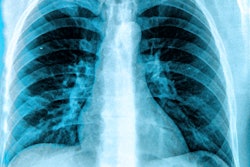An AI algorithm can help identify rare tumors on upper arm bones in patients undergoing chest x-rays – findings not typically identified in daily reading practice, according to an article published March 6 in Radiology: Artificial Intelligence.
The algorithm improved the ability of radiologists to identify the tumors, which are located at the periphery of chest x-ray images, noted lead authors Harim Kim, MD, and Kyungsu Kim, PhD, of the Samsung Medical Center in Seoul, South Korea.
“Radiologists showed improved performance with assistance of the AI program, particularly in terms of sensitivity and accuracy. We expect that this program will alert radiologists about humeral abnormalities, particularly in cancer centers and tertiary hospitals,” the group wrote.
Primary humeral tumors and humeral metastases are extremely rare conditions, the authors explained. The incidence of primary malignant bone tumors in the U.S. is 0.9 per 100,000 people per year, with between 8.5% and 11.8% of these located in the humerus.
Despite their rarity, missing these tumors on imaging can delay timely diagnosis and treatment, which can increase patient morbidity and mortality, they wrote. The group proposed that their algorithm could serve as an aid in these cases.
The data for training and testing the algorithm included 14,709 chest x-rays collected from 13,468 patients, including 13,116 CT-proven normal or abnormal images (to serve as “ground truth”) and 1,593 humeral tumor cases.
 The tumor localization/visualization results obtained by the proposed AI algorithm. Original chest x-ray images with a lesion (red circle = radiologists’ annotation of the lesion location) and AI's lesion localization result. These examples demonstrate that the proposed technique can successfully detect humeral tumors. Image and caption courtesy of Radiology: Artificial Intelligence.
The tumor localization/visualization results obtained by the proposed AI algorithm. Original chest x-ray images with a lesion (red circle = radiologists’ annotation of the lesion location) and AI's lesion localization result. These examples demonstrate that the proposed technique can successfully detect humeral tumors. Image and caption courtesy of Radiology: Artificial Intelligence.
The researchers trained the algorithm using a relatively new technology in the field known as “false-positive activation area reduction” (FPAR), a technique that reduces its likelihood of false positives by training it to focus on the target region. This is significant, given that the lung area is typically the region of interest (ROI) in chest x-rays, they noted.
After training, 10 radiologists (five trainees and five expert thoracic radiologists) participated in a test to assess the algorithm using a separate set of 219 chest x-rays that included 112 normal images and 89 abnormal images with CT-proven humeral tumors. The radiologists read the images with and without the help of the algorithm.
On a per-patient level, an analysis showed that the AI demonstrated higher accuracy compared to the radiologists (84% vs. 76%, p = 0.02) and that radiologists improved performance with AI assistance from 76% to 81% (p < 0.001), according to the findings. There were no significant differences in the performance of trainees and expert radiologists before or after AI assistance, the researchers added.
“The proposed AI tool incorporating FPAR improved humeral tumor detection on [chest x-rays] and reduced false positives in tumor visualization,” the authors wrote.
However, the group noted limitations. Namely, the radiologists who participated in the study were instructed to target the humerus in chest x-rays so that their reads may not correlate with real-world practice.
“Considering the low prevalence of humeral tumors, our AI system will be more valuable as a supportive diagnostic tool in cancer-rich populations, such as cancer centers and tertiary hospitals, than in general screening setting,” the group concluded.
A link to the full study can be found here.



















